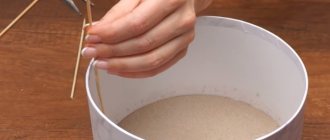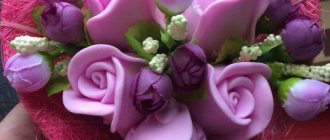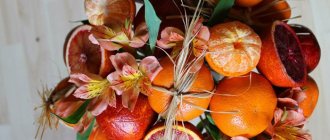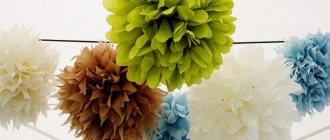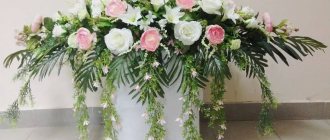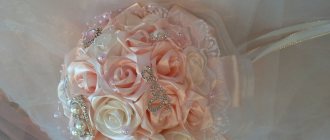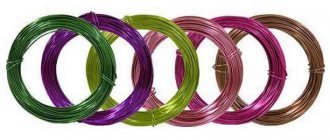The bride's bouquet
- How to assemble a wedding bouquet of fresh flowers with your own hands?
- Master class on making a bridal bouquet from live spray roses
- How to assemble a bride's wedding bouquet with a porta bouquet step by step with your own hands
- How to make your own bouquet of wildflowers
- How to make the base of a bouquet yourself: step-by-step instructions
A wedding is an important day in a girl’s life, and the main accessory for her wedding dress is a bouquet. You can order its production from a professional florist, but a composition created by yourself looks much more interesting.
How to assemble a wedding bouquet of fresh flowers with your own hands?
How to make a bridal bouquet from fresh flowers with your own hands: first of all, you need to get acquainted with the basic composition techniques. For each bouquet it is selected individually.
23 Apr 2021 at 11:01 PDT
Advantages and disadvantages of different options for arranging wedding bouquets:
- A bouquet made from your own flower stems without auxiliary options can be placed in a vase with water so that the flowers are saturated with moisture and retain their freshness longer. The difficulty is that it is impossible to create a complex composition in this way, since the stems do not bend, and the stem of the bouquet will turn out to be quite voluminous.
- A bouquet of flowers that are fully or partially secured with wire : it is inserted into the stem or placed on top of it. This technique allows you to bend the stems as you like and create an original bouquet shape . But the composition itself will be heavy in weight.
- Taped bouquet - the stems are cut to the length required by the bouquet design and secured on a wire, which is wrapped with green floral ribbon. The advantage is that you can arrange a bouquet of any complexity, but the main disadvantage is the lack of nutrition for the flowers. Therefore, they will retain their fresh appearance for a short time.
- The stems are completely cut off, and the inflorescences are attached to a thin wire, which is attached to a thicker one. Thus, inflorescences and branches are formed. Such a bouquet will be very elegant and beautiful, but short-lived , as in the previous version.
- A bouquet with a port-bouquet, where the stems are strengthened in a special moistened sponge. This bouquet is made quickly, it can be given a round or flowing shape, and the flowers will not fade for a long time . If the flowers are large, the composition will be heavy.
- Glue technique : petals and flowers, leaves are attached to the surface of the base with glue. This bouquet is assembled very quickly, but is distinguished by its fragility.
- A frame bouquet uses a small flask of water that is attached to a stem or inflorescence. Flowers take moisture well, and you can create an interesting composition. But such bouquets are usually very bulky and inconvenient.
A glass or plastic flask can be filled with tinted water and give plants unusual shades and an additional color effect
Various workshops for making bouquets will help you decide on the choice of composition and choose a convenient way to create a wedding bouquet for the bride.
The process of creating a bridal bouquet
DIY wedding bouquet of peony roses with their own stems
DIY bridal bouquet of roses and lilies with wire
Bride's bouquet of tulips using glue technique
Bridal bouquet: composition traditions and superstitions
Most girls, on the most important day of their lives, try to follow the traditions that came to us from ancient times. It is generally accepted that with their help you can find true happiness and harmoniously enter a happy family life. There are also those young ladies who absolutely do not follow traditions.
In any case, they are worth knowing about.
- Artificial flowers have never been used in bouquets. It is generally accepted that artificial flowers mean dead flowers and their place is in the cemetery. A young and beautiful bride, just entering into a happy family relationship, should have fresh flowers in her hands.
- Florists say that flowers have their own language and you need to know it so as not to express the wrong emotions. The rose represents passion, the orchid - affection, the tulip - sincerity and pure love, the lily - gratitude, the wild rose - jealous feelings.
- It is better if the wedding bouquet is collected by the groom. Traditionally in Rus', grooms wove wreaths for their brides or made beautiful bouquets of wildflowers. Before the wedding, young guys handed fragrant plants to their spouses. Such a gift was considered a talisman against the evil eye and evil spirits.
- The bride takes care of her wedding attribute all day long. At the end of the evening, as one tradition says, you should play your accessory among your friends by tossing it. According to another superstition, the bouquet should go home with the spouses. Nowadays girls have become cunning and use two customs. Initially, two accessories are made: one is thrown, with the other the girl goes to the marital home. The easiest way is to initially analyze whether there are unmarried girlfriends. If there are very few of them or none at all, then it is better not to throw a bouquet. Traditionally, throwing a bouquet is not a Russian tradition, but an American tradition. In Rus', girls blindfolded the bride and danced around her. The young lady was spinning around and where she stopped, that girl received field daisies, symbolizing imminent marriage.
Interesting to know: Artificial bouquet - which bride is best suited?
Master class on making a bridal bouquet from live spray roses
Shrub rose is the most popular plant among florists. A bouquet of small buds will suit any bride's look and will give it fragility and femininity.
It is recommended to start creating such a bouquet a few hours before the wedding ceremony, so that it does not begin to fade by the middle of the celebration.
To make a stylish bouquet, you need to prepare:
- bush roses;
- twigs for decoration;
- green floral ribbon;
- pins;
- satin ribbon matching the color of the flowers.
How to do:
- Remove leaves and thorns from flowers. Trim the stems so that their length is about 30 cm.
- Choose 2-4 flowers that will form the basis of the composition. Fold into a bouquet and tie with floral tape at a distance of 10 cm from the bottom of the stems.
- Add one rose at a time, securing it with ribbon each time. Flowers that are placed around the base should be attached slightly lower to give the bouquet a round shape . If desired, you can add some twigs for decoration.
- Wrap the finished bouquet with floral tape along the stem and trim the bottom.
- Wrap a satin ribbon around the stem in a spiral and secure with pins. Then make a second layer and attach with a small pin to the bottom of the stem.
A bouquet of spray roses is ready!
Bouquet of cream-colored spray roses DIY bouquet of red spray roses
Bright bridal bouquet of multi-colored spray roses
Useful video: master class on creating a cascade composition
Cascade compositions are very popular among modern brides. It will not require serious skills or unusual materials. How to create a bridal bouquet with your own hands step by step can be seen in the video below:
A DIY wedding bouquet is created from the following materials:
- oasis (portable bouquet);
- white roses, freesias and eustomas;
- greens: ruscus and bergrass;
- soft transparent wire;
- pruner;
- satin ribbon;
- pearl beads;
- transparent glue.
A DIY wedding bouquet is assembled step by step as described below.
- First, let’s install the portaquet holder in a position convenient for work. A tall vase that holds the oasis in a vertical position is suitable for this.
- We take three roses with the smallest flowers or buds. We cut the leg at an angle so that it is convenient to insert it into the oasis. We wrap the edge of the leg tightly with wire. These three roses will be the basis of the entire cascade.
- We insert the roses into the oasis from bottom to top, at an acute angle. We fix the wire inserted along with the legs on the other side of the portaquet. This is necessary so that the flowers do not fall out under their own weight. Roses arranged in a cascade should be arranged asymmetrically.
- We also insert the remaining few roses asymmetrically throughout the oasis ball. To do this, you need to cut off the entire stem, leaving a stem 6-7 cm long.
- The free space between the roses is filled with freesia flowers. A flower can be inserted into a portaquet holder 1 time. If you placed it poorly, you will have to make a new hole. The oasis material is fragile.
- To the cascade of roses we add long (along the length of the cascade) branches of ruscus. Since the greens are lightweight, there is no need to secure them with wire. We just stick the branches in like roses – from the bottom up. We insert several separate short branches of ruscus throughout the composition, among roses and freesias.
- We also insert eustoma inflorescences, from bottom to top, into the cascade, filling the space between the roses.
- We string beads onto a wire, scatter them in separate drops and fix them throughout the composition.
- The edge of the porta bouquet's leg is covered with ruscus leaves, the rest of the space is decorated with a satin ribbon. Now you know exactly how to make a bridal bouquet with your own hands.
Important! Flowers in the oasis are not secured by anything - therefore, it is better to hold a simple bridal bouquet created with your own hands vertically or place it in a vase. Read more about bouquets on bouquet holders in this article.
How to assemble a bride's wedding bouquet with a porta bouquet step by step with your own hands
Many brides like a spherical bouquet, as they look unusual and fabulous. Forming a porta bouquet has several secrets , thanks to which you can significantly prolong the fresh appearance of flowers.
What you will need:
- porta bouquet holder;
- satin ribbon;
- foam sponge;
- double sided tape;
- tape for taping;
- scissors or pruning shears;
- glue gun;
- water;
- any flowers.
How to do it:
- Open the portaquet holder and insert a sponge in the shape of a ball. It needs to be evenly saturated with cold water : it is very convenient to do this using an ordinary syringe. To prevent moisture from the sponge from wetting the bouquet handle, you need to place a small oblong piece of sponge under it, which will absorb excess liquid and protect the handle from getting wet.
- Attach leaves in a circle to the expanding part of the porta bouquet with double-sided tape.
- The end of the satin ribbon must be glued to the end of the handle. Then cover the entire surface of the handle with double-sided tape and wrap the tape in a spiral. Secure the tip using a hot glue gun.
- Cut the leaves diagonally and insert sponges into the cuff. An oblique cut will increase the area of the leaves, which will absorb moisture and the greens will remain fresh for a long time.
- It is recommended to choose small roses from flowers. Cut the stems to 6 cm and insert evenly into the sponge so that it is completely hidden under the buds.
From the same color of roses you can make boutonnieres for witnesses and the groom, as well as decorate the microphone of the wedding host - it will look beautiful and organic.
What does a porta bouquet look like?
Wedding bouquet of roses and eustoma with porta bouquet
DIY bouquet of white freesias with a porta bouquet
Making a beautiful arrangement is easy
It is best to choose seasonal plants for your wedding. Firstly, they will be the freshest, strongest and most durable when cut. Secondly, they will be budget-friendly.
If you want something unusual, you can add a few exotics to simple garden plants - today such a “misalliance” is not only acceptable, but also welcomed by professional florists.
In winter, it is recommended to rely not on Dutch cuttings, but on “available” natural materials: pine cones, cotton, beautiful dried flowers.
Accessory for a rustic wedding
The rustic or rustic style, with its spontaneity, closeness to nature and associations that bring back childhood, is one of the most popular today. A simple bridal bouquet, collected from ordinary country flowers, without any additional devices or techniques, such as taping or a porta bouquet, is suitable for it.
You will need:
- country flowers with large and small buds, for example, sunflowers, zinnias, garden lilies, delphinium, Japanese skimmia, eryngium, lavender;
- pruning shears, tape;
- decorative braid made of natural linen, twine, pins.
First, we clean all the plants from the lower leaves. The composition is assembled on its stems using a spiral technique. The base is made up of large buds of zinnia and lilies. We surround them with vertical inflorescences of delphinium and lavender, and add lush skimmia brushes for volume.
At the last stage, we introduce bright accent sunflowers and eryngium. We fix the stems with tape, stretching it well so that the flowers do not fall apart and cut them to the same length. You can decorate a rustic composition with natural linen lace, and tie it with sisal twine. We decorate the junction of the edges of the braid with decorative pins.
We assemble the groom's boutonniere in a similar style.
Affordable classics
Looking at the photo of such an unusual bouquet of fresh flowers as a pomander, I can’t believe that you can make it yourself. Meanwhile, this is the most affordable option for classic floristry. Following the step-by-step instructions, even an amateur can assemble it. Thanks to the use of an “oasis” for fresh plants, the composition will last a very long time and will delight its owner throughout the celebration.
During a wedding, the pomander should never be put down; it is hung by its holder and stored that way.
Roses of different types and shades are perfect for a romantic accessory: bush, single-headed and peony-shaped. The master class uses a rare variety of “ostok” called “Green Eye”, but it can be replaced with any analogues of a purple hue. In addition to flowers you will need:
- floral “oasis” (piaflor) in the shape of a ball, D 15 cm;
- decorative satin ribbon 5–7 cm wide;
- pruner;
- wire.
We make a long loop from a satin ribbon with the expectation that the pomander on it will not reach the floor in a freely lowered hand. We cut the wire, about 40 cm long. We bend it in half, put a satin loop holder inside and insert the resulting paper clip into the piaflora ball. The wire must pass through so that its ends stick out from the back side, and the tape fits tightly to the “oasis”. The result is a strong mount. All that remains is to bend the free ends of the wire and stick them back into the “oasis”.
Immerse the piaflora ball in water at room temperature. Roses that have been previously “unsoldered” for at least 2 hours are cut obliquely to a stem length of 3–4 cm. We insert them into the “oasis”, alternating buds of different shapes, colors and shades. First, we place the floral ball on a stand, and then we decorate the lower part while it is in weight.
A wedding pomander bouquet of roses will create an elegant and romantic look at the same time.
This exciting shade of magenta
A great way to convey your mood on your wedding day is to choose a monochrome arrangement in a rich, rich shade. Magenta - a combination of pink and purple will make the image sensual and exciting, plus it will give you the opportunity to show your originality and taste. By choosing buds of similar shades, the bride will avoid the need to worry about the correct color combination. But at the same time, her floral accessory will not turn out boring.
You will need:
- fresh magenta flowers: spray roses, peonies, heather, freesia, as well as shepherd's purse and echeveria;
- string pruner;
- satin ribbon.
Traditionally, we collect the prepared plants in a spiral, alternating accent peony buds and fillers: bush rose, heather, freesia. We attach the succulents to floral wire and add them to the bouquet arrangement. When the flowers are almost collected, we create an interesting asymmetry using the long branches of the shepherd's purse. We fasten the stems with twine to reduce injury to them. And then we tie a spectacular silk ribbon.
Flower cascade
The cascade technique of making arrangements is much more complicated than the round or free one and requires the use of a porta bouquet. However, based on a detailed and competent master class, it is possible to assemble a falling composition with your own hands. Although it is somewhat heavy and bulky, the overall image is very impressive.
- live plants: roses, ostinki, eucalyptus, serpuria, nigella, astrantia, sweet peas, salal;
- a special portbouquet with a curved handle for cascading compositions;
- tape, narrow satin braid, floral glue, heat gun.
How to make your own bouquet of wildflowers
A delicate bouquet of daisies will perfectly complement the bride’s image without distracting everyone’s attention from her. Chamomiles last well for a long time without water and are suitable for an eco-style wedding. Such a bouquet can be made very quickly with your own hands, and it will save the situation when there is very little time left to create a flower arrangement.
What is needed for the bouquet:
- 15-20 daisies;
- green floral ribbon;
- gardening scissors;
- ribbon or fabric for decoration.
How to do:
- Fold three chamomile stems crosswise. Apply the remaining flowers in a spiral. To get the correct spiral, daisies should be placed exactly diagonally, adding a few flowers inside so that there are no voids left and the volume of the bouquet increases.
- When creating the shape of the bouquet, evaluate its appearance in the mirror so that you can correct it in time. The inflorescences should be located approximately at the same level.
- In the middle of the stems, tie them with green ribbon.
- Trim the bottom of the stems with scissors so that it becomes smooth and neat.
- Wrap satin ribbon or overlapping fabric around the stems, leaving the lower part uncovered.
- Tie a bow from a small piece of ribbon or fabric.
Daisies can be folded at an angle of 90 degrees, then the shape of the bouquet will be spherical . And to make it lighter, you can cut off the length of the stems.
Wedding bouquet of daisies
Bouquet for the bride of daisies and other wildflowers
Original bouquet for the bride of wild flowers
Useful video: how to make an accessory on stems
The master class below will help you create wedding bouquets with your own hands:
If you are planning a wedding, you can make your own bridal bouquet from the following materials:
- peonies;
- Japanese Tabernacle;
- branches of pistachio and salal;
- scissors;
- floral tape or thread;
- decorative elements.
- To begin with, we sort the peonies separately - the blossoming flowers separately from the buds.
- Remove all excess leaves from the peony stems. We leave only those that are in close proximity to the flower.
- We prepare the flowers of the tabernacle - we cut off the extra branches, leaving only straight stems with inflorescences. We remove excess leaves.
- We select straight salal branches, cut off all the ugly and damaged leaves, remove all the leaves, leaving a few at the top.
- We process the pistachio in the same way, leaving only the top with intact, undamaged leaves.
The composition on the stems is assembled in a spiral. The technique is something like this: take one plant and around it, in a circle, with a slight slope, add new plants and greenery. The tops of flowers and greenery should fit snugly against each other and be approximately at the same level. Bouquets in this arrangement are made slightly convex, in the form of a small hemisphere.
- We take several of the fluffiest pistachio branches in the center and begin to collect salal branches around them. This green bouquet will be the base to which we will add flowers.
- In the resulting composition, add a large, blooming peony flower to the very center, insert a peony bud and a couple of tabernacle branches next to it. And gradually, in a circle, we add more flowers. Place flowers of different sizes nearby: large inflorescences with buds and just blooming flowers. This way the accessory will look varied and natural.
- We carefully correct the resulting hemisphere, fixing the leg of the accessory with wire or other auxiliary materials. It must be fixed well so that the composition does not lose its shape or fall apart.
- At a distance of 5-7 cm from the base, we fix the leg again. Your palm should fit comfortably between the two clamps.
- We retreat a couple more centimeters and evenly cut off the leg of the accessory.
- We decorate the leg with ribbons, closing the latches, and decorate to taste.
